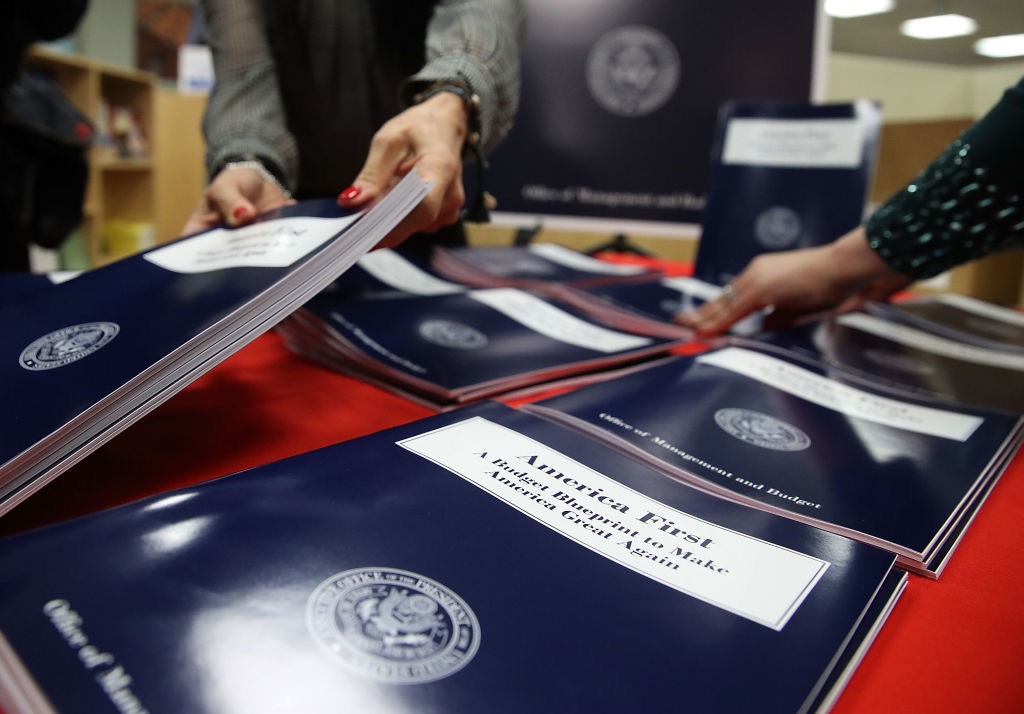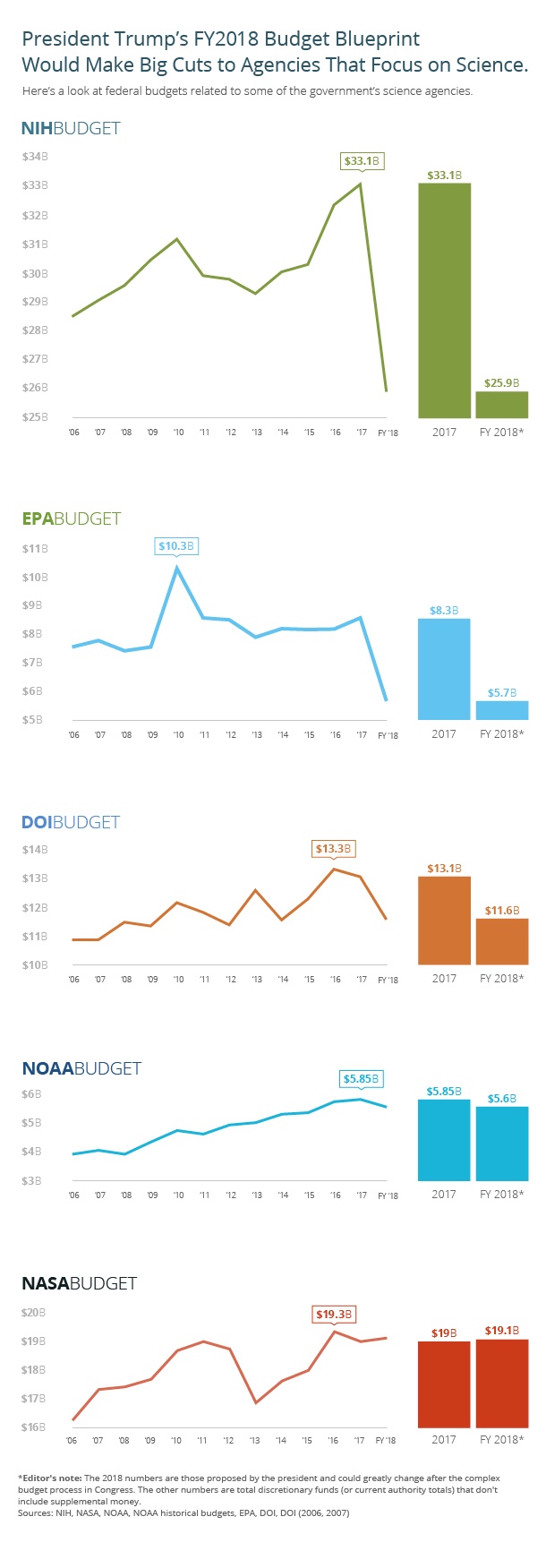How Trump's Budget Would Impact Science

President Donald Trump released his administration's preliminary 2018 budget proposal today, a request that would see funding slashed for most government agencies, including top federal science institutions.
Among the hardest hit under the White House's initial budget proposal is the Environmental Protection Agency, which would see its budget shrink by 31 percent over 2017 levels, according to the Office of Management and Budget. The budget request proposes large increases for defense and homeland security, but most other agencies will see cuts under this preliminary outline, which details only discretionary (not mandatory) spending. [What If the EPA Was Abolished?]
This budget proposal is far from a done deal, and now begins the grueling debate over spending according to news reports. The House and Senate Budget Committees will hold hearings to question officials about the budget and then will develop their own budget plans, called budget resolutions, along with 12 appropriations bills for federal programs for the fiscal year that starts on Oct. 1, 2018.
Here's how the Trump administration's 2018 budget proposal would affect the nation's science agencies.
Environmental Protection Agency (EPA)

Trump's budget proposal requests $5.7 billion for the agency, a cut of $2.6 billion, or 31 percent, from the previous year.
The budget would:
—Eliminate more than 50 EPA programs, such as Energy Star (which supports energy-efficient products and buildings), Targeted Air Shed Grants (a program that assists in controlling air pollution at the local level); and the program that screens for endocrine disruptors, such as mercury and BPA that impact humans' hormone systems. [10 Ways the EPA Has Protected Earth and You]
Sign up for the Live Science daily newsletter now
Get the world’s most fascinating discoveries delivered straight to your inbox.
—Stop funding the Clean Power Plan, which was signed by President Barack Obama in 2015 to cut carbon emissions from current power plants.
—Impact climate change science by discontinuing funding to related international programs, research, partnership programs and related climate change efforts. (President Trump has said he would pull out of international agreements to curb greenhouse gas emissions, including the Paris Agreement, which aims to combat climate change in an international effort — so far 134 countries have signed the treaty.)
—Reduce funding to the Hazardous Substance Superfund Account aimed at cleaning up toxic waste sites that have been declared Superfund sites; the EPA would have to use existing settlement money to clean up these hazardous waste sites.
—Eliminate funding to some regional environmental efforts, such as funds for the Great Lakes restoration initiative and one for the Chesapeake Bay, among other geographic programs.
Department of the Interior (DOI)
The DOI manages and protects the United States' lands and waters, provides scientific information about its natural resources and ensures that the nation meets its responsibilities toward native peoples.
Trump's budget proposal requests that the DOI cut $1.5 billion, a 12 percent cut to its overall budget.
The budget would:
—Expand spending for energy development programs that drill for gas and oil on public lands. It would also streamline the permitting processes, giving industry faster access to energy resources. [The Oil & Gas Industry's Fractured Fairy Tales (Op-Ed)]
—Cut $120 million from a program that buys new federal lands, and spend discretionary money on maintaining existing national parks, refuges and public lands.
—Eliminate federal funding for National Heritage Areas and the National Wildlife Refuge System. (The NWRS employs more than 3,000 individuals, according to their website.)
—Invest more than $1 billion in "safe, reliable and efficient management of water resources" in the western United States.
National Aeronautics and Space Administration (NASA)
NASA runs the civilian space program and funds aerospace and astrophysics research. It has several areas of focus, including better understanding the Earth through Earth observation systems, understanding the physics of the sun, exploring space and gaining insight into the early origins of the universe.
Trump's budget proposal requests $19.1 billion for the agency, which is a small cut relative to previous years.
The new budget would:
—Eliminate the Asteroid Redirect Mission, a proposed mission to land on a large near-Earth asteroid, mine a large boulder from it, and then redirect it into stable orbit around the moon, as part of a larger project exploring how to gain resources for a trip to Mars. [How It Works: NASA Asteroid-Capture Mission in Pictures]
—Increase planetary science research to levels higher than those achieved under President Obama.
—Continue the Europa Clipper Mission, a mission to fly by Jupiter's moon Europa; the lander designed to gather samples has not been budgeted for.
—The new budget does not weigh in on whether the next big mission should focus on going to Mars or the moon, though unlike Obama's budget, it does not focus on Mars. Trump has previously expressed an interest in another manned mission to the moon.
Earth Science gets a substantial cut, particularly programs focused on climate change:
—Programs on the chopping block include PACE, or the Plankton, Aerosol, Cloud, ocean Ecosystem, which uses satellite systems to monitor the color of the oceans as a proxy for their health, and gain new insight into aerosols and clouds.
—The Orbiting Carbon Observatory, the Deep Space Climate Observatory, and the CLARREO Pathfinder, which measures atmospheric heat to test climate models and predictions, are all set to be canceled. All of these programs are focused on better understanding climate change.
—The Office of Education, which provides summer camps, enrichment programs, and STEM (science, technology, engineering and math) programming for kids is being cut.
Department of Energy (DOE)
The DOE oversees the nation's energy policies and research, including nuclear energy, and the environmental impacts of energy production and consumption. All the national laboratories in the U.S. are overseen by the DOE, including the National Renewable Energy Laboratory in Colorado and the Fermi National Accelerator Laboratory in Illinois. Together, the 17 national labs form one of the world's largest scientific research institutions.
Trump's 2018 budget proposal requests $28 billion for the agency, which is a $1.7 billion cut, or about 6 percent, relative to the previous year.
The new budget would:
—Restart the Yucca Mountain project, a controversial storage facility for nuclear power plant waste, with $120 million to restart licensing operations.
—Cut $900 million from the DOE's Office of Science, which supports 10 of the national labs and scientific research at more than 300 universities and institutions of higher learning across the country.
—Eliminate programs focused on lowering carbon emissions, including the Title 17 Innovative Technology Loan Guarantee Program, which supports low-carbon energy projects, and the Advanced Technology Vehicle Manufacturing Program.
—Eliminate the Weatherization Assistance Program, which is used by states and some Native American tribes to assist low-income families in improving the energy efficiency of their homes.
The Department of Health and Human Services (HHS)
The HHS includes two major health and medical arms: The Centers for Disease Control and Prevention and the National Institutes of Health.
Trump's budget proposal requests a nearly 18 percent cut from the previous year, equivalent to a reduction of about $15 billion.
Here's how the HHS could be affected.
The Centers for Disease Control and Prevention (CDC)
The Trump administration's budget proposal does not include a specific figure for the CDC, which has a current core budget of about $7 billion, nor does the preliminary request list programs that might be cut, The Washington Post reported.
The proposed budget would:
—Increase spending by $500 million to help fight opioid abuse and provide access to treatment.
—Create a new Federal Emergency Response Fund for public health outbreaks such as the Zika virus. According to the Washington Post, however, it is not clear how much money this fund would receive or if the money would come from other CDC programs.
National Institutes of Health (NIH)
The National Institutes of Health, a large funder of scientific research across the country, would see a $5.8 billion cut in its budget under Trump's new proposal. That's a 19 percent decrease from its current budget. The large cut could prove disruptive to researchers who rely on NIH grants to carry out studies over several years, according to the Washington Post. To implement these cuts, Trump's budget proposes a "major reorganization" of the NIH's 27 institutes and centers.
The proposed budget would:
—Eliminate the NIH's Fogarty International Center, which supports global health research and helps build partnerships between research institutions in the United States and abroad.
—Make the Agency for Healthcare Research and Quality part of the NIH. The Agency for Healthcare Research and Quality, which had been its own agency within HHS, is focused on improving the safety and quality of the U.S. health care system.
—Initiate "other consolidations and structural changes across NIH organizations and activities." Though the budget proposal offers few other specifics about what will change at the NIH, it would also reduce administrative costs and "rebalance Federal contributions to research funding," the administration said.
National Oceanic and Atmospheric Administration (NOAA)
NOAA oversees research and programs that forecast weather and storms, monitor climate, and manage marine and freshwater communities and ecosystems, to better understand the processes that drive our dynamic planet, and to help predict changes in a warming world.
NOAA operates within the Department of Commerce, where it was placed upon its creation in 1970 by former President Richard Nixon. Nixon allegedly made this unorthodox choice — rather than designating NOAA as part of the Interior Department — as a reprimand directed against the Interior Secretary Wally Hickel for criticizing Nixon's policies on Vietnam, President Barack Obama recounted on Jan. 13, 2012.
Trump's budget proposal would cut more than $250 million of funding for NOAA programs and grants that support marine and coastal research, management and education.
The new budget would:
—Eliminate Sea Grant, which employs thousands of scientists, engineers and outreach experts to work with U.S. coastal communities, managing resources and fueling sustainable economic growth. Funded in 2015 at $67.3 million, Sea Grant's economic impact that year was estimated at $575 million — a 854 percent return — according to a January 2017 report.
—Continue development of NOAA's weather satellites, which contribute critical weather data to the Joint Polar Satellite System (JPSS) and Geostationary Operational Environmental Satellite (GOES) programs, though the amount of money allocated to these programs was not specified.
Also unspecified was the amount of "annual savings" expected to be extracted from NOAA's Polar Follow On (PFO) satellite program. The administration will re-evaluate the risks of incomplete polar coverage by satellites, and examine the possibility of bolstering weather models with commercially sourced data, according to the budget description.
Live Science reporters Tia Ghose, Mindy Weisberger, Sara Miller, Rachael Rettner, Laura Geggel, Kacey Deamer, Jeanna Bryner and Denise Chow contributed to this report.
Original article on Live Science.










